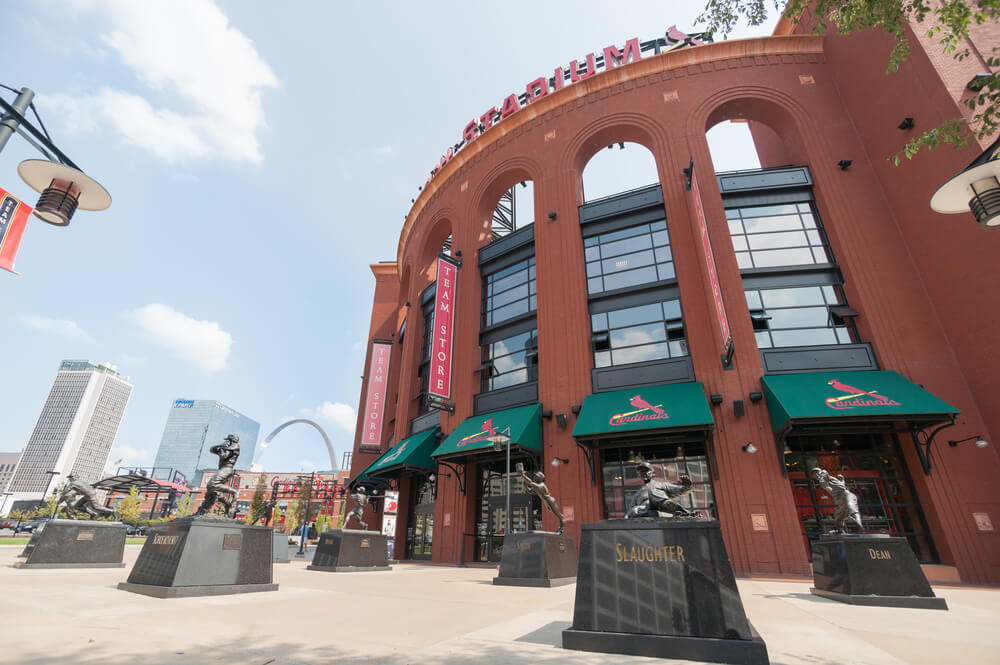Beyond the Scoreboard: The Economic Power of Missouri’s Pro Sports
- April 10, 2025
Want to understand the economic impact of sports? Come to Missouri and find a real-life case study. Since hosting the 1904 Summer Olympics, Missouri’s sports industry has evolved into a cornerstone of the state’s thriving economy.
Iconic Missouri franchises are at the heart of this story. The Kansas City Chiefs, St. Louis Cardinals, St. Louis Blues, and other teams generate billions in revenue through ticket sales and sponsorships. Their success supports local businesses, fuels job creation, attracts tourism and investment, and strengthens the state’s national and global reputation.
You can also look at the 2026 FIFA World Cup, which will take place in Kansas City. The positive impact of the World Cup and other high-profile events is palpable. Visitors from around the world flock to Missouri, leading to increased hotel stays, restaurant spending, tax revenue, and infrastructure investment.
All this explains why Missouri is investing in stadium renovations, training facilities, and sports venues. These developments ensure the state remains competitive in attracting teams, events, and new opportunities in the evolving sports industry.
The Kansas City Chiefs: A Super Bowl Dynasty Boosting the Economy
The Kansas City Chiefs are more than just a dominant force in the NFL — they are a major economic driver for Missouri’s economy. From Super Bowl victories to game-day revenue, football’s modern-day dynasty fuels local businesses, sports tourism, and brand recognition on a national scale.
The Chiefs have appeared in seven Super Bowls, including five appearances in the last six NFL seasons. For Kansas City, the return on investment for every Super Bowl victory is huge. In 2023, the team’s spending resulted in nearly $1 billion in economic impact for the region, supporting approximately 5,860 jobs annually.
Then there’s Arrowhead Stadium, the Chiefs’ home turf. Each home playoff game generates an estimated $16 million in direct economic impact for Kansas City, benefitting local businesses such as hotels, restaurants, and retail shops. This sports prowess also feeds into a multiplier effect. In 2023, Taylor Swift played two shows at Arrowhead that produced an estimated $47.8 million in economic benefit. Beyoncé’s performance that same year contributed approximately $16 million to Missouri.

The Kansas City Royals: Pitching New Possibilities in Missouri
Visit Arrowhead, and you’ll notice another sports facility right next door: Kauffman Stadium, home of the Kansas City Royals. The Major League Baseball team occupies a key place in Missouri’s sports culture, with two World Series titles in its belt. Since 1973, the Truman Sports Complex has housed both Arrowhead and Kauffman — with the latter heralded as one of the most beautiful ballparks in the world. The Royals are currently considering options to build a new $2 billion stadium and ballpark district in downtown Kansas City or to renovate Kauffman Stadium. Economic projections for the downtown development are promising. Within its first year of operation, a new downtown Royals stadium could generate an impact of $880 million, create 5,400 new jobs, and bring $300 million in employee earnings. Combined with a fully operational entertainment district, the project could ultimately create 26,000 jobs with $1.8 billion in salaries, culminating in a total economic impact of $3.8 billion.
The St. Louis Cardinals: A Legacy of Fan-Driven Economic Growth
Traveling to the other side of Missouri, the St. Louis Cardinals are one of the most successful and well-supported franchises in Major League Baseball. The Cardinals have a storied history, bringing home 11 World Series titles to St. Louis. That legacy of success translates into significant economic benefits for the city and surrounding region.
According to Forbes, the Cardinals are valued at $2.55 billion as a brand, placing them among MLB’s most valuable sports franchises. In recent seasons, Busch Stadium has drawn approximately 3 million fans each year — fans who spend big on hotels, restaurants, and retail in St. Louis. In 2024, the Cardinals ranked No. 7 in the league for average attendance. A single season of home games generated more than $310 million in economic activity for the St. Louis metro area.
Meanwhile, the Springfield Cardinals, the Double-A affiliate of the St. Louis Cardinals, draw more than 250,000 fans annually. The Minor League team bolsters local businesses and contributes to the economic development of Springfield, Missouri.

The St. Louis Blues: Hockey’s Economic Power in Missouri
Just a few blocks away, the St. Louis Blues deliver top-tier hockey action while serving as a major economic engine for Missouri through their home games and burgeoning championship legacy. The Enterprise Center, home to the Blues, hosts more than 175 events annually — including NHL games, concerts, and other major gatherings.
The team’s games consistently draw large crowds to downtown St. Louis. According to city estimates, St. Louis collects $300,000 in direct tax revenue for every Blues playoff home game from tickets, parking, and concessions.
Few can forget when the Blues won their first Stanley Cup trophy in 2019. That championship run was also an economic win for Missouri. The 2019 finals generated a $50 million impact on the region — the combined revenue from tickets, merchandise, and sales at hotels, bars, and restaurants. Sales of Blues championship apparel and memorabilia skyrocketed, setting an NHL record for the most sales in a 12-hour period after winning the title, Bloomberg reported.

Soccer’s Rise: St. Louis CITY SC and Kansas City’s Women’s Soccer Stadium
Missouri is also experiencing a transformative renaissance in major league soccer. St. Louis CITY SC’s Energizer Park stadium has become a catalyst for downtown revitalization, generating more than $168 million in regional economic impact during its inaugural 2023 season.
The Kansas City Current’s CPKC Stadium offers another case in point, as the nation’s first stadium built for women’s soccer. Capable of seating 11,500 people, the groundbreaking stadium is expected to generate an annual economic impact of $48.8 million for Missouri — capitalizing on the sport’s growing popularity.
Moreover, Kansas City is gearing up to be a host city for the 2026 FIFA World Cup, one of 15 in North America. The tournament is projected to inject more than $695 million into the local economy. The influx of sports tourism, infrastructure investments, and international exposure will further solidify the city’s status as a world-class hub for major sporting events.

The UFL and Alternative Sports Driving Growth
Alternative sports are also making a breakthrough in Missouri, resulting in positive economic effects. The St. Louis Battlehawks set a modern spring football attendance record in 2024, with 40,317 fans attending their home opener at The Dome at America’s Center. Throughout the 2024 season, the Battlehawks led in attendance for the United Football League (a new merger of the XFL and USFL), averaging 34,365 fans per game. That’s more than double the average of any other UFL team.
When the Savannah Bananas announced St. Louis as a stop in their 2025 world tour, Missouri responded with unbridled enthusiasm. Within the first 72 hours of the ticket lottery going live, more than 160,000 people entered for a chance to see the high-flying baseball exhibition team at Busch Stadium — driving the highest ticket demand in the nation.
Missouri’s Sports Economy: A Winning Play for the Future
With a rich legacy and bright future, Missouri’s professional sports teams are vital to the fabric of many communities across the state. It’s clear that the economic impact of sports is on an upward trajectory in the state. The upcoming 2026 World Cup, new stadiums, versatile sports facilities, and fast-growing fan bases all present opportunities for businesses to enter the field as players in Missouri’s sports-driven economy.
From top sports teams to a strong job market, learn more about living in Missouri.